
(By Suresh Chotai): In a dazzling start to the new year, the 2-day India Gold and Jewellery Summit (IGJS) illuminated the landscape of the gold and jewellery industry on January 23 and 24, 2024. This annual event brought together luminaries, thought leaders, and industry stakeholders to discuss, discover, and celebrate the ever-evolving facets of India’s vibrant gold and jewellery sector.
Day 1: Setting the Stage for Brilliance The summit kicked off on January 23 with a grand inauguration ceremony, where industry pioneers set the stage for two days of insightful discussions and networking. Keynote speakers shared their perspectives on the current state of the industry, highlighting emerging trends and market dynamics. The day was marked by engaging panel discussions on design innovation, consumer preferences, and the integration of technology in jewellery creation.
A highlight of Day 1 was the exclusive exhibition area, where renowned jewellers and brands showcased their latest collections. Attendees had the opportunity to witness firsthand the craftsmanship and innovation that define the Indian jewellery market, from traditional heirlooms to contemporary masterpieces.
Day 2: Navigating Challenges and Embracing Opportunities January 24 brought a deeper exploration of challenges and opportunities facing the industry. Regulatory experts and policymakers took the stage to discuss evolving policies, compliance measures, and the impact of geopolitical factors on the gold and jewellery market. A thought-provoking session on sustainability underscored the industry’s commitment to responsible practices in mining and sourcing.
The digital transformation of the sector took center stage on Day 2, with discussions on e-commerce strategies, blockchain applications, and the role of augmented reality in reshaping the customer experience. The summit provided a platform for industry players to share success stories, challenges faced, and collaborative solutions that pave the way for a more resilient and technologically advanced future.
The summit concluded on a high note with recognizing excellence in various categories, including design innovation, sustainability, and corporate responsibility, the event celebrated the achievements of individuals and organizations shaping the future of the gold and jewellery sector.
The 2-day India Gold and Jewellery Summit 2024 left attendees inspired and enriched with valuable insights. From embracing digital advancements to addressing sustainability concerns, the summit provided a holistic view of the industry’s trajectory. As the participants dispersed, the echoes of collaborative discussions and the shimmer of exquisite jewellery collections lingered, signaling a promising and dynamic future for the Indian gold and jewellery sector.
KEY TAKEAWAYS FROM ‘SPECIAL SESSION – DRIVING THE NEW-AGE BUSINESS:
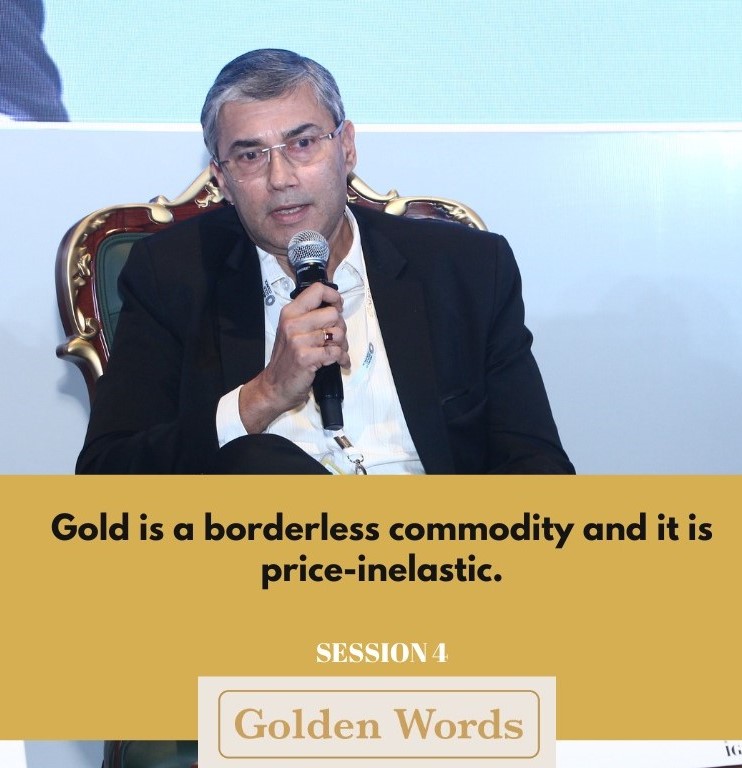
👉 The organised jewellery market is outperforming the overall market growth.
👉 In Europe, vintage/pre-owned jewellery is expected to grow as buyers look to differentiate.
👉 Product innovations such as 24-kt hard gold, and heritage gold have improved the inclination of Chinese Gen Zs to buy gold from 16% (2016) to 64% (2023).
👉 In the Middle East, personalised jewellery is set to gain traction.
👉 Demand driven in India due to Government policy support Hallmarking, GMS, export promotion schemes; omnichannel customer experience; rising income levels, and growing discretionary spending.
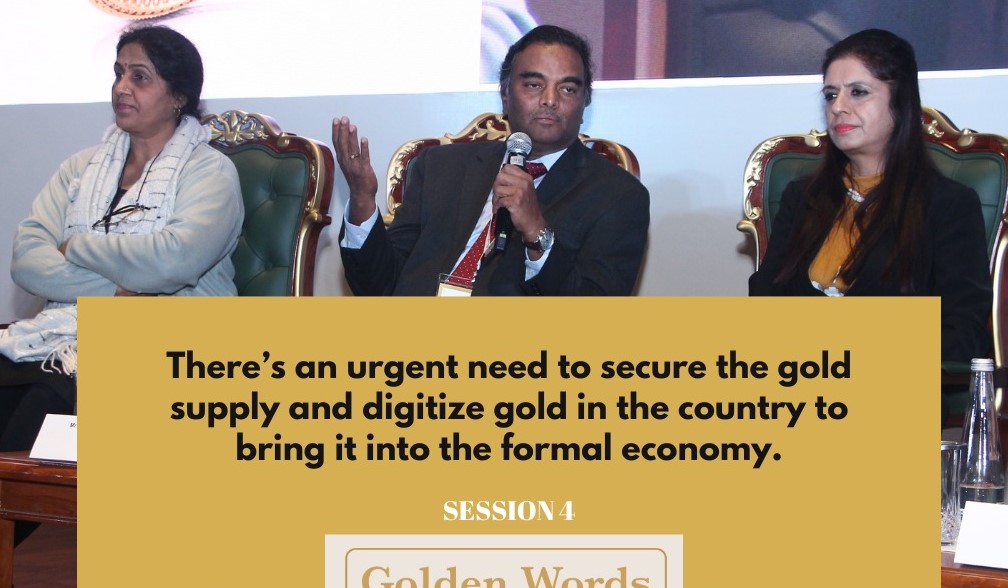
👉 The growth of an organization has to be the growth of every stakeholder.
👉 De Beers is positive about the future sourcing of diamonds. The diamond business is expected to grow 2.5 times by 2030. The company aims to be more India-focused.
👉 De Beers focuses on the 4 Pillars of Brand, Source Transparency, Digital Everywhere, and Purpose.
👉 Train karigars to bring professionalism to the business.
The need of the hour is to change our thinking that what was successful in the past will continue to be successful in the future.
👉 The Indian gem and jewellery industry has changed 180 degrees from where it was 10-15 years ago, with greater professionalism, organised stores and high-quality jewellery.
KEY TAKEAWAYS FROM THE SESSION SECURING SUPPLY OF GOLD/DIGITISATION OF GOLD:
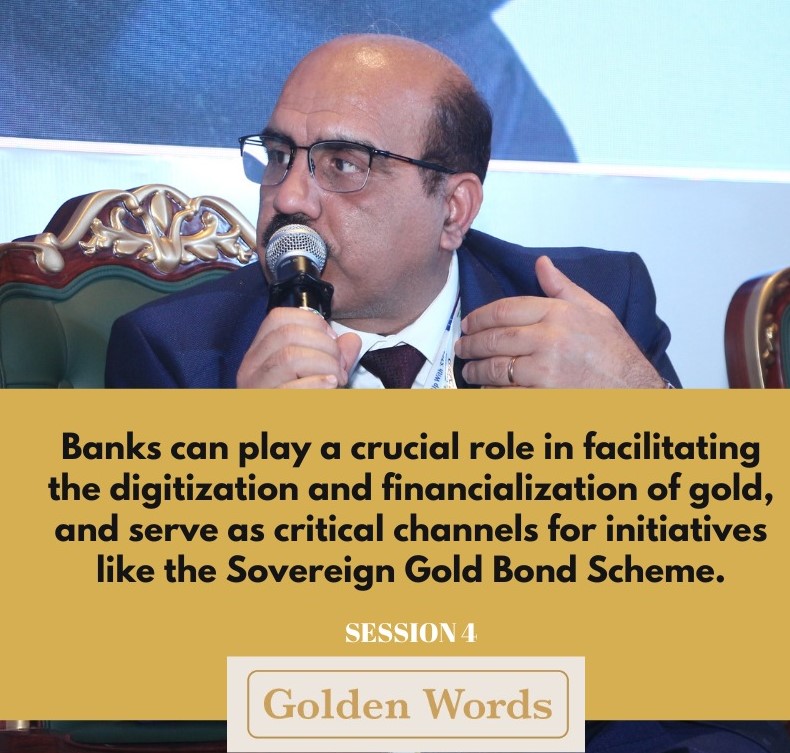
👉 There’s an urgent need to secure the gold supply and digitize gold in the country to bring it into the formal economy.
👉 Despite challenges, there is optimism about improving the gold refining capacity and leveraging technologies to enhance schemes like the Gold Monetization Scheme (GMS).
👉 Banks can play a crucial role in facilitating the digitization and financialization of gold, and serve as critical channels for initiatives like the Sovereign Gold Bond Scheme.
👉 There’s a need for a regulatory framework for digital gold products.
👉 Gold is a borderless commodity and it is price-inelastic.
👉 Tax and duty drawback disparities (ad valorem versus specific) are affecting potential gold jewellery exports from India and must be addressed through immediate policy intervention within the legal framework. If solved, it could drive up gold exports 10x from India.
KEY TAKEAWAYS FROM THE SPECIAL SESSION ADDRESSED BY RUPA DUTTA, PRINCIPAL ECONOMIC ADVISOR, DPIIT:
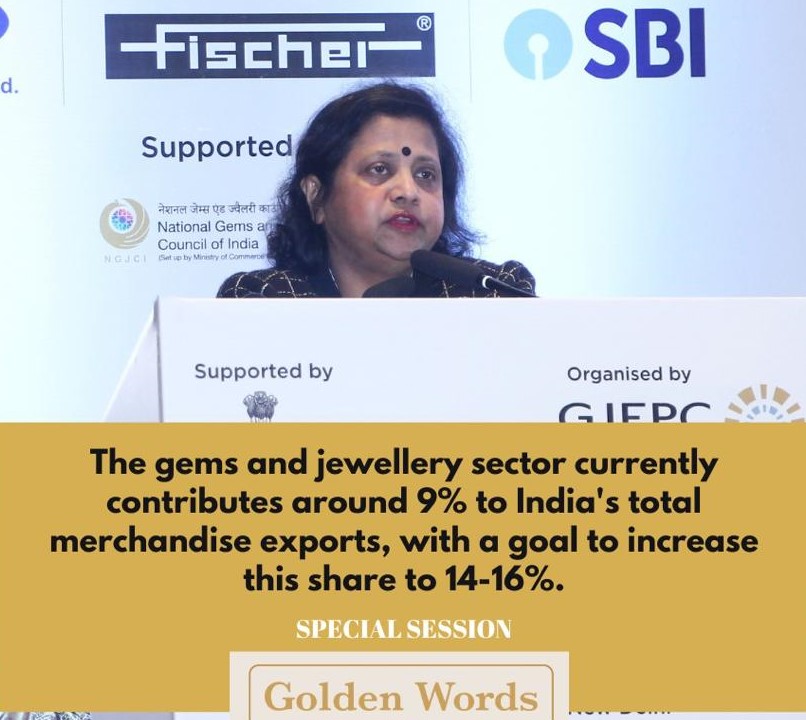
👉 The gems and jewellery sector currently contributes around 9% to India’s total merchandise exports, with a goal to increase this share to 14-16%.
👉 Employing 5 million people, the sector is a significant contributor to the nation’s economy, particularly with a focus on gold, which alone contributes around 9.4 billion to exports.
👉 India is recognised as one of the oldest and largest manufacturers of handmade gold jewellery, with a rich heritage in craftsmanship.
👉 India is the 4th largest exporter of gold, following major players such as China, UAE, and Switzerland. The industry aims to achieve total exports of 75 billion by 2030.
👉 The government has introduced several initiatives to support the sector, including mandatory hallmarking, increased duty drawback rates, and trade agreements like the India-UAE CEPA.
👉 Quality Control Orders have played a crucial role in boosting exports and reducing imports, emphasizing the importance of maintaining high standards.

👉 The establishment of facilities like the IJEX in Dubai, the Bharat Ratnam Mega CFC in SEEPZ, Mumbai, and the upcoming Jewellery Park in Navi Mumbai signifies the government’s commitment to providing end-to-end solutions and creating employment opportunities.
👉 Global exports of gold jewellery reached $113 billion, with India contributing 8-9%. The sector is expected to witness further growth with upcoming FTAs like UK, Europe, GCC, and more.
👉 There’s a need to explore ways to monetize gold, including popularizing the Sovereign Gold Bond scheme, introducing gold-backed financial products, and integrating the ODOP scheme with GI trademarks.
👉 Leveraging e-commerce platforms, including the establishment of the IIBX, is crucial for the sector’s growth.
👉 As India aims for a 32 trillion-dollar economy by 2047, the gems and jewellery industry must focus on moving up the value chain, embracing innovation, and ensuring quality control to thrive in the global market.
KEY TAKEAWAYS FROM THE SPECIAL INTERACTIVE SESSION WITH MR. SANTOSH KUMAR SARANGI, DG, DGFT, MINISTRY OF COMMERCE & INDUSTRY, GOVT. OF INDIA:
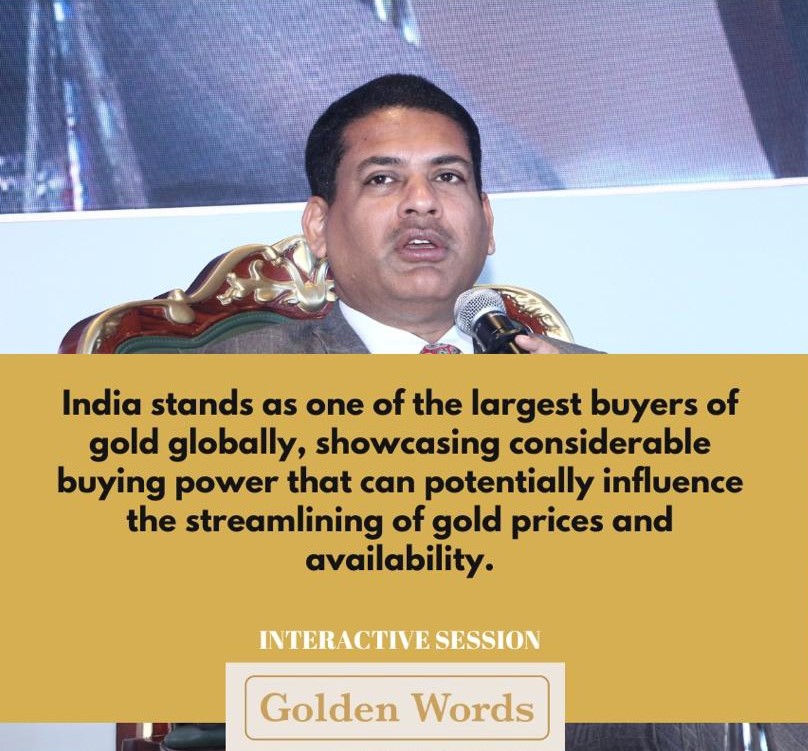
👉 India stands as one of the largest buyers of gold globally, showcasing considerable buying power that can potentially influence the streamlining of gold prices and availability.
👉 Recognising the fragmented nature of gold demand in India, spanning from small to large jewellers and varying from kilograms to tons, there’s a pressing need for streamlining.
👉 India currently holds the position of the 4th largest exporter. With immense potential, the aim should be to become the foremost exporter globally.
👉 Drawing a parallel with Switzerland, we need champions in India investing in creative designs catering to Western tastes.
👉 Collaboration between the Department of Commerce, GJEPC, and leading brands is essential to formulate a robust branding strategy positioning India as a top supplier and value-added provider of gold jewellery.
👉 Challenges related to ICR rules, tariff rate quotas, and other obstacles will be addressed in tandem with the gems and jewellery division in DOC.
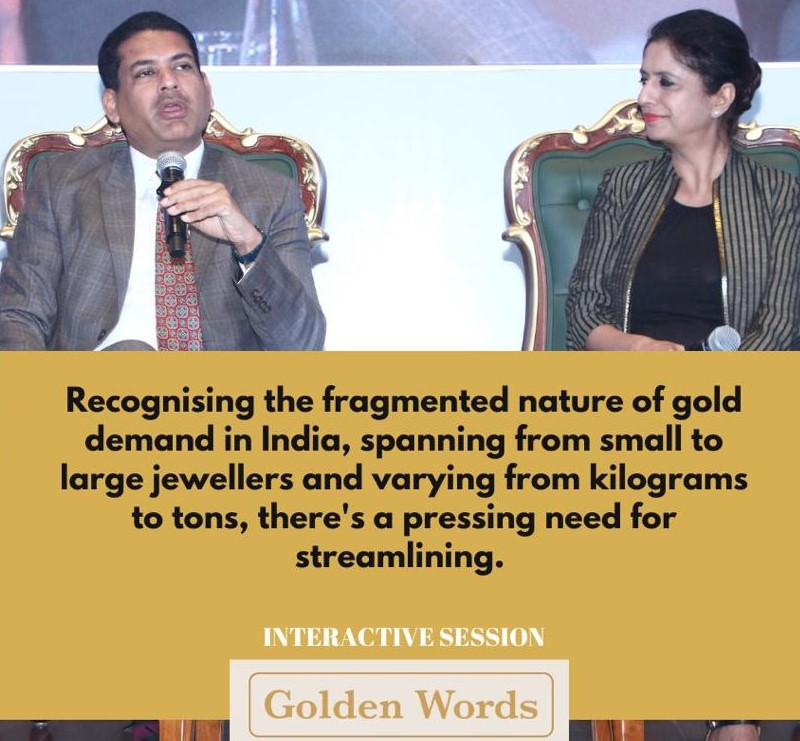
👉 Integration of CAD, CAM, and AI for design creation, sourcing, and virtual presentation to customers is essential for future growth.
👉 GJEPC urged to take the lead in creating a virtual exhibition centre to showcase new designs in a three-dimensional environment, thereby supporting small and medium-level jewellers, and securing international purchase orders.
👉 The potential of e-commerce in cross-border transactions is vast, with estimates predicting a rise to 2 trillion dollars by 2030. To encourage this platform, the consignment value for e-commerce exports is increased to Rs.10,00,000.
👉 GJEPC urged to organize outreach programs in interior regions to facilitate understanding and adoption of e-commerce platforms.
KEY TAKEAWAYS FROM THE SESSION “ RAISING COMPLIANCE THROUGH RESPONSIBLE REPORTING IN INDIA”:
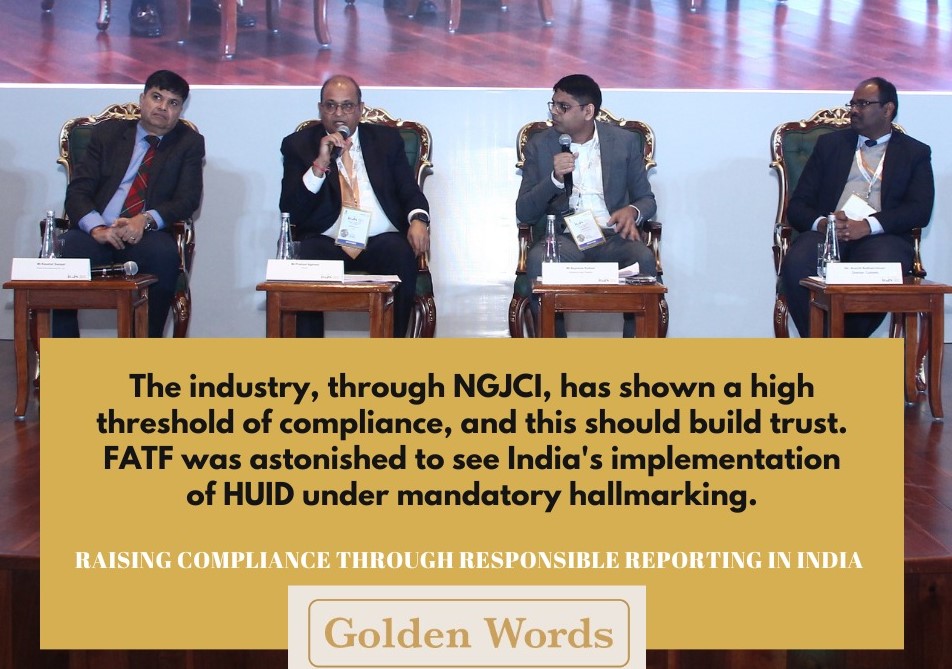
👉 The My KYC initiative by GJEPC focuses on validating the identity of council members globally. The platform verifies various details and is a permanent ID on the platform, accessible to authorised entities for verification. Though the process is a one-time exercise, it requires annual validation.
👉 It is vital to balance compliance and trade promotion policies with measures to prevent abuse and revenue leakage. There is a need for a harmonious reading of multiple legislations, and challenges arise due to different interpretations.
👉 For gems and jewellery, a separate group (3A) has been created for the faceless assessment of sensitive commodities like diamonds.
👉 Efforts are being made for partial recredit in the electronic bond and bank guarantee system.
👉 The industry, through NGJCI, has shown a high threshold of compliance, and this should build trust. FATF was astonished to see India’s implementation of HUID under mandatory hallmarking.
KEY TAKEAWAYS FROM THE SESSION- INDEPENDENT STORE & ORGANISED RETAIL – A SUSTAINABLE CO-EXISTENCE:
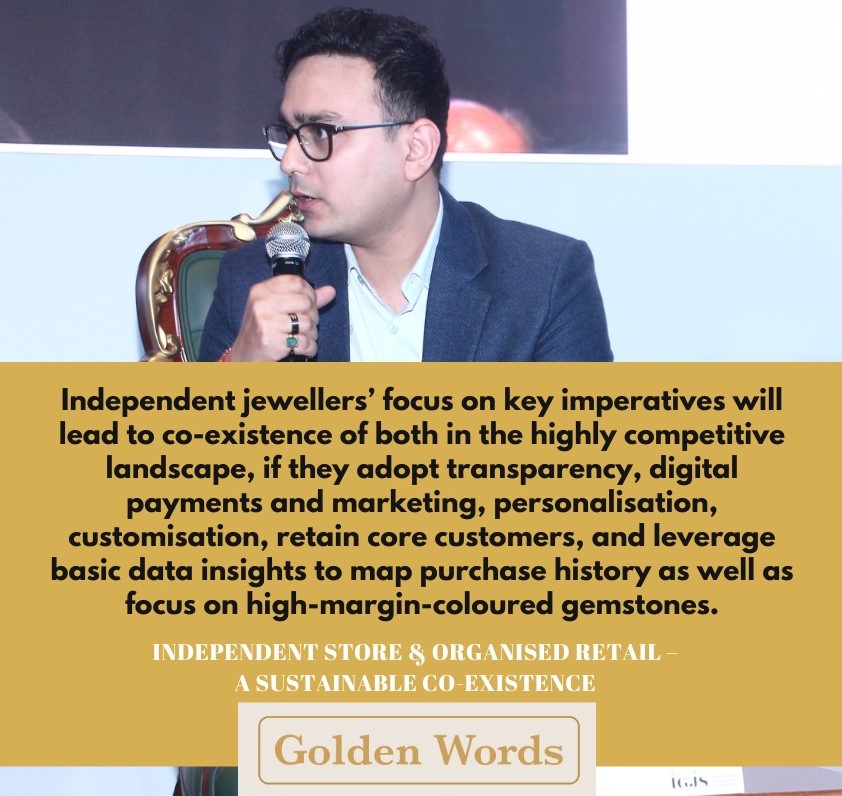
👉 India is the third largest fine jewellery market; Highest share of GDP and is over-indexed on gold. And, India has shown a strong growth rate ahead of other peers like China and the US.
👉 The market size of the Indian fine jewellery market, in 2023 is Rs. 4.5 Lakh crore, and is expected to grow in double digits by 2030.
👉 In India, the Branded Jewellery market represented ~35% share and is expected to reach~40% by 2027.
👉 Top players in the branded segment are expected to grow in the range of 15-18% in 2024; expansion to spill further from metros to tier-1, and 2 cities; Rising e-commerce salience in the industry with branded players omnichannel offerings and the emergence of DTC players.
👉 Globally Branded jewellery is taking market share from unbranded jewellery, a trend that appears secular and to continue in the medium term.
👉 Chained players are directing their focus from modern contemporary to traditional styles as well, as women increasingly embrace aesthetic collections and inclusivity.
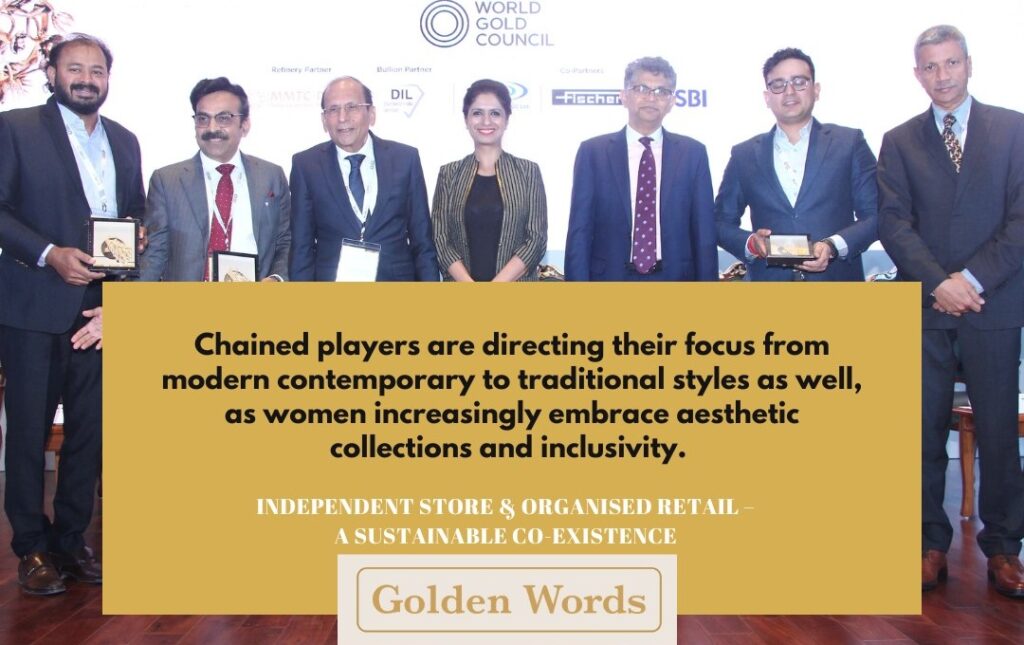
👉 Independents have started to pivot their focus from core traditional to modern contemporary featuring diamond and gemstone portfolios.
👉 Independent jewellers’ focus on key imperatives will lead to the co-existence of both in the highly competitive landscape if they adopt transparency, digital payments and marketing, personalisation, customisation, retain core customers, and leverage basic data insights to map purchase history as well as focus on high-margin-coloured gemstones.
👉 Customer loyalty is very flimsy and they are willing to explore all their options. First-time buyers feel big chains offer a sense of safety and security.
Exclusive coverage by Suresh Chotai



